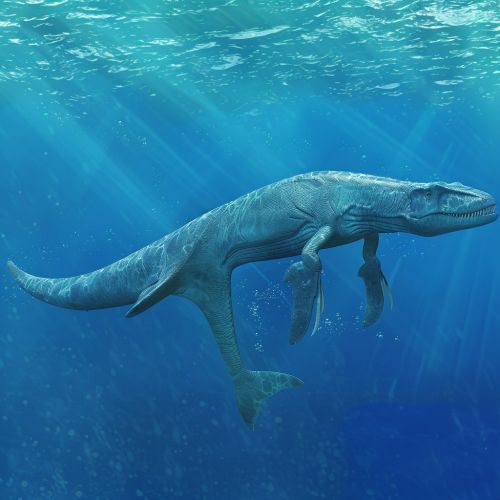Ichthyosauria: Difference between revisions
(Created page with "== Introduction == Ichthyosauria, commonly known as Ichthyosaurs, were a group of aquatic reptiles that lived during the Mesozoic Era. They first appeared in the early Triassic period and disappeared in the late Cretaceous period. Ichthyosaurs were highly specialized marine predators, with adaptations for life in the open ocean similar to those of modern dolphins and whales. <div class='only_on_desktop image-preview'><div class='image-preview-loader'></div></div><di...") |
No edit summary |
||
| Line 2: | Line 2: | ||
Ichthyosauria, commonly known as [[Ichthyosaurs]], were a group of aquatic reptiles that lived during the Mesozoic Era. They first appeared in the early Triassic period and disappeared in the late Cretaceous period. Ichthyosaurs were highly specialized marine predators, with adaptations for life in the open ocean similar to those of modern dolphins and whales. | Ichthyosauria, commonly known as [[Ichthyosaurs]], were a group of aquatic reptiles that lived during the Mesozoic Era. They first appeared in the early Triassic period and disappeared in the late Cretaceous period. Ichthyosaurs were highly specialized marine predators, with adaptations for life in the open ocean similar to those of modern dolphins and whales. | ||
[[Image:Detail-78931.jpg|thumb|center|A realistic depiction of an Ichthyosaur swimming in the ocean.]] | |||
== Evolution and Classification == | == Evolution and Classification == | ||
Revision as of 05:12, 16 May 2024
Introduction
Ichthyosauria, commonly known as Ichthyosaurs, were a group of aquatic reptiles that lived during the Mesozoic Era. They first appeared in the early Triassic period and disappeared in the late Cretaceous period. Ichthyosaurs were highly specialized marine predators, with adaptations for life in the open ocean similar to those of modern dolphins and whales.

Evolution and Classification
Ichthyosauria is a taxon within the larger group, Diapsida, which also includes modern reptiles and birds. The exact evolutionary origins of Ichthyosaurs are not well understood, but they are believed to have evolved from a group of land-dwelling reptiles that returned to the sea. Over time, Ichthyosaurs evolved a streamlined body shape, a large tail fin, and paddle-like limbs, all of which are adaptations for fast swimming in the open ocean.
The classification of Ichthyosaurs has been a subject of debate among paleontologists. The group is traditionally divided into two suborders: the Parvipelvia, which includes smaller, more primitive forms, and the Eurhinosauria, which includes larger, more advanced forms. However, some recent studies have suggested that this traditional classification may not accurately reflect the evolutionary relationships among different Ichthyosaur species.
Anatomy and Physiology
Ichthyosaurs were characterized by their dolphin-like body shape, with a streamlined body, a dorsal fin, and a large tail fin. They had long, narrow jaws filled with sharp teeth, which they used to catch fish and squid. Their eyes were large, suggesting that they were capable of hunting in low light conditions.
One of the most distinctive features of Ichthyosaurs was their paddle-like limbs. These limbs were not used for propulsion, but for steering and stability. Propulsion was provided by the large tail fin, which was vertically oriented and crescent-shaped, similar to the tail fins of sharks and dolphins.
Ichthyosaurs were air-breathing animals, and they had to surface regularly to breathe, just like modern whales and dolphins. They were also viviparous, giving birth to live young rather than laying eggs. This is known from fossil evidence showing pregnant Ichthyosaurs with embryos inside their bodies.
Paleobiology and Ecology
Ichthyosaurs were top predators in their marine ecosystems. They fed on a variety of prey, including fish, squid, and possibly other marine reptiles. Their teeth and jaws were well adapted for catching and holding onto slippery prey.
Ichthyosaurs were highly adapted for life in the open ocean. They were capable of fast swimming, and they probably used their speed and agility to chase down their prey. They were also capable of deep diving, as suggested by their large eyes and the structure of their ear bones.
Ichthyosaurs lived in a wide range of marine environments, from shallow coastal waters to the open ocean. They were globally distributed, with fossils found on every continent.
Extinction
Ichthyosaurs went extinct in the late Cretaceous period, about 90 million years ago. The cause of their extinction is not well understood, but it is believed to have been a combination of environmental changes and competition with other marine predators.
